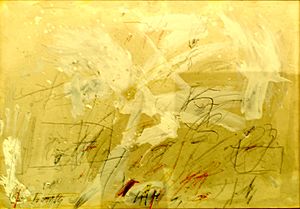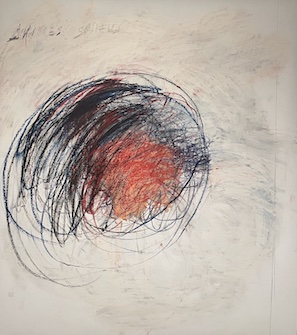Cy Twombly facts for kids
Quick facts for kids
Cy Twombly
|
|
|---|---|
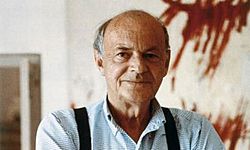
Twombly in his studio
|
|
| Born |
Edwin Parker Twombly Jr.
April 25, 1928 Lexington, Virginia, U.S.
|
| Died | July 5, 2011 (aged 83) Rome, Italy
|
| Education |
|
| Known for | Painting, sculpture, calligraphy |
| Spouse(s) |
Tatiana Franchetti
(m. 1959; died 2010) |
| Awards | Praemium Imperiale, Legion of Honor |
Edwin Parker "Cy" Twombly Jr. (/saɪ ˈtwɒmbli/; April 25, 1928 – July 5, 2011) was an American painter, sculptor, and photographer. He was part of the same group of artists as Robert Rauschenberg and Jasper Johns.
Twombly's art style was very unique. He often made large paintings with free, scribbled lines that looked like calligraphy or graffiti. He used mostly gray, tan, or off-white backgrounds. Later in his career, his art became more about "romantic symbolism." He would use shapes, forms, and words to show his ideas. Twombly often included quotes from famous poets like Stéphane Mallarmé and John Keats, and also ideas from old myths. For example, he made a series of drawings that just said the word "VIRGIL."
Many famous museums around the world have Twombly's artwork. These include the Menil Collection in Houston, the Tate Modern in London, and New York's Museum of Modern Art. He even painted a special ceiling at the Musée du Louvre in Paris. Some art experts have said that his work was very important for other artists, even if it was sometimes hard for people to understand at first.
Contents
Who Was Cy Twombly?
Twombly was born in Lexington, Virginia, on April 25, 1928. His father, also called "Cy," was a baseball pitcher for the Chicago White Sox. Both of them were nicknamed after the famous baseball player Cy Young.
When he was 12, Twombly started taking art lessons from a modern artist named Pierre Daura. After high school, he studied art at several schools, including the School of the Museum of Fine Arts, Boston and the Art Students League of New York. There, he met another important artist, Robert Rauschenberg. Rauschenberg encouraged him to go to Black Mountain College, where he learned from famous artists like Franz Kline and Robert Motherwell.
In 1951, Twombly had his first art show in New York. His early work was influenced by the bold, black-and-white art of Franz Kline. In 1952, he received a grant that allowed him to travel to North Africa and Europe with Robert Rauschenberg. After his travels, he served in the U.S. Army as a cryptographer, which is someone who decodes secret messages. This experience influenced his art style.
In 1957, Twombly moved to Rome, Italy, which became his main home. He married Italian artist Tatiana Franchetti in 1959. They bought a beautiful old building in Rome and also had a villa outside the city. They had one son, Cyrus Alessandro Twombly, who also became a painter. Cy Twombly lived in Italy for most of his life. He passed away in Rome in July 2011, after being ill for some years.
What Was Cy Twombly's Art Like?
His Unique Painting Style
After his time in the army, Twombly worked in New York. He became a key artist alongside friends like Robert Rauschenberg and Jasper Johns. He became interested in abstract art, which uses shapes, colors, and forms instead of realistic pictures. He also liked tribal art.
Twombly developed a special way of drawing. He would make thin, white, scribbled lines on a dark canvas, almost as if he was scratching the surface. He sometimes used a material called bitumen on his canvases, which made them feel rough and textured. These energetic, scribbled lines became his signature style.
In the 1960s, Twombly often wrote the names of mythological figures on his paintings. Moving to Italy connected him more with ancient Greek and Roman stories. He created artworks based on myths like Leda and the Swan.
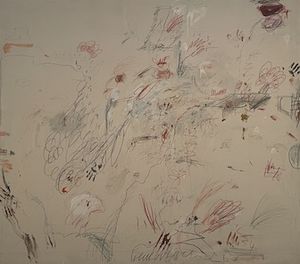
Some people found his art confusing at first. For example, when he showed his nine-panel series Discourses on Commodus in 1964, one artist said there were "a few drips and splatters and an occasional pencil line," and that there wasn't much to the paintings. But these works are now shown in famous museums.
Between 1967 and 1971, Twombly made a series of "grey paintings." These works had short, colorless scribbles on gray backgrounds, like chalk on a blackboard. They didn't form real words but looked like writing. For some of these, he used a unique method: he sat on a friend's shoulders while his friend moved back and forth, allowing Twombly to create long, flowing lines across the canvas.
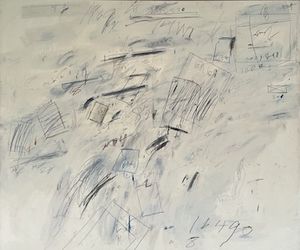
In the mid-1970s, Twombly started to use colors like brown, green, and light blue in his paintings to suggest landscapes. He also added written words and collage pieces. In 1978, he created a huge ten-part series called Fifty Days at Iliam, inspired by Homer's famous story, the Iliad. He continued to use literature and myths in his art, like in his monumental Four Seasons series.
Some critics wondered if his seemingly random marks were just "scribbles" that "my kid could do." However, art experts defended his work, explaining its deeper meaning. Twombly, along with Rauschenberg and Jasper Johns, is seen as a very important artist who moved away from the earlier style of abstract art.
His Sculptures
Twombly also made sculptures. From 1976 onwards, he created sculptures that were often painted white and looked like old Greek or Roman art. He once explained that making sculptures was like "building something," while painting was more about "fusing ideas" and feelings.
Where Can You See His Art?
Twombly's art has been shown in many galleries and museums around the world. He had exhibitions at famous places like the Leo Castelli Gallery and the Gagosian Gallery. In 2007, a new Gagosian Gallery opened in Rome with a show of Twombly's work.
In 1993, an exhibition of his photographs showed blurry color pictures of flowers, trees, and old statues. In 2008, a special show of his photos was held in Amsterdam. For the 2010/2011 season, Twombly designed a huge picture called Bacchus for the Vienna State Opera. In 2011, a big show of his photographs from different years was held in Germany and Belgium.
Just before he passed away in 2011, Twombly's work was shown alongside paintings by the famous artist Nicolas Poussin in London. This show explored Twombly's connection to classical art. His work has also been displayed at the Art Institute of Chicago and in "The Last Paintings" exhibition, which traveled to different cities in 2012.
Big Art Shows (Retrospectives)
Twombly's art has been featured in many large shows that look back at his whole career. The first one was in 1968 at the Milwaukee Art Museum. Later, major retrospectives were held at the Whitney Museum of American Art in New York (1979), the Kunsthaus Zürich (1987), and the Museum of Modern Art in New York (1994).
In 2001, an exhibition focused only on his sculptures, showing 66 works he made over many years. A big European show called Cy Twombly: Cycles and Seasons opened at the Tate Modern in London in 2008 and then traveled to Spain and Italy. His work was also part of a show called Turner Monet Twombly: Later Paintings in Liverpool in 2012.
Art in Collections
Many museums have permanent collections of Cy Twombly's art.
- In 1989, the Philadelphia Museum of Art opened special rooms for his huge 10-painting series, Fifty Days at Iliam, which is based on The Iliad.
- The Cy Twombly Pavilion at the Menil Collection in Houston, designed by famous architect Renzo Piano, opened in 1995. It holds over thirty of Twombly's paintings, sculptures, and drawings.
- The Museum Brandhorst in Munich has 170 of his works, including the "Lepanto series."
- The Broad Collection in Los Angeles has 22 of his pieces.
In 1995, Twombly gave his series The Four Seasons to the Museum of Modern Art in New York. In 2004, the Art Gallery of New South Wales bought a recent work by Twombly, Three Studies from the Temeraire, for A$4.5 million.
In 2010, Twombly created a special painting called Ceiling for the Salle des Bronzes (Bronze Room) at the Musée du Louvre in Paris. He was only the third artist ever invited to create a permanent artwork for the Louvre in this way. In 2011, the Museum of Modern Art in New York bought nine more of his works for about $75 million. In 2014, Twombly's family gave his "Bacchus" series and five bronze sculptures to the Tate Modern.
The Art Institute of Chicago also had a two-year exhibition of his sculptures, which were often made from rough wood covered in plaster and white paint. The Institute also has his prints, drawings, and paintings.
Awards and Honors
Twombly received many awards for his art. In 1996, he was given the Praemium Imperiale, a very important international art award. He was also invited to show his work at the Venice Biennale several times, and in 2001, he won the Golden Lion award there. In 2010, the French government made him a Chevalier of the Légion d'Honneur, which is a high honor.
Cy Twombly Foundation
After Cy Twombly passed away, most of his art and money went to the Cy Twombly Foundation. This foundation now takes care of much of his artwork. In 2012, the foundation bought a large building in New York City. They plan to open an education center and a small museum there to share his art with more people.
In 2021, the Cy Twombly Foundation and the Louvre museum worked together to fix a problem with Twombly's The Ceiling mural. The foundation had sued the Louvre because of changes made to the room where the painting was. They agreed to a plan to restore the gallery to how Twombly originally designed it.
His Art in the Market
Cy Twombly's artworks are very valuable. In 1990, one of his "blackboard paintings" from 1971 sold for $5.5 million at an auction. In 2011, another work sold for $15.2 million. A new record was set in May 2012 when his 1970 painting Untitled (New York) sold for $17.4 million. In November 2013, Poems to the Sea (1959), a 24-part artwork on paper, sold for $21.7 million.
Another record was set in November 2014, when an untitled 1970 painting from his "Blackboard" series, with its unique "lasso-like scribbles," sold for $69.6 million. In November 2015, New York City (1968) set another new price record for Twombly. This painting, with its looping white scribbles on a gray background, is thought to be connected to his time as a cryptologist.
The "Phaedrus" Incident
In 2007, during an exhibition of Twombly's paintings in France, a woman named Rindy Sam kissed one of his all-white paintings called Phaedrus. Her red lipstick left a smudge on the artwork. She was arrested and taken to court for damaging a work of art.
Sam said that her kiss was "a loving gesture" and "an artistic act provoked by the power of art." The painting was worth about $2 million. In November 2007, she was found guilty and ordered to pay money to the painting's owner, the gallery, and to Twombly himself.
See also
 In Spanish: Cy Twombly para niños
In Spanish: Cy Twombly para niños


